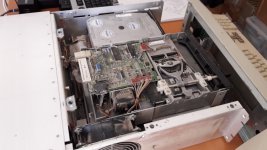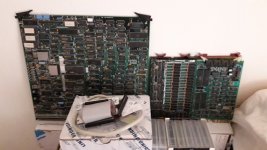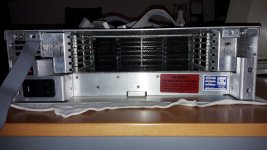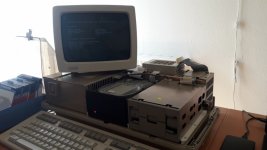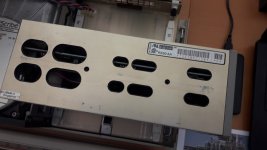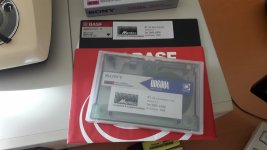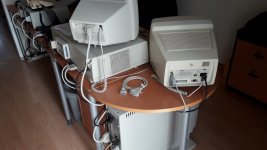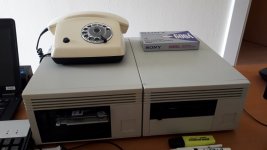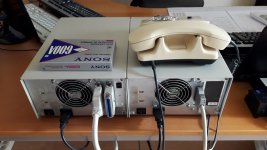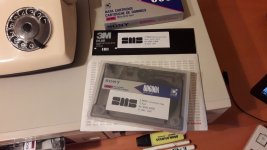Hi there!
Maybe one of you also has a PDP-11 which was not made by DEC, like my SMS 1000 and maybe someone would like to run Unix on this PDP-11. In any case, I have put together a 2.9BSD system for my SMS-1000 Model 40, which works with the SMS MSCP Controller as well as it supports the SMS QIC02 tape controller.
Why? - Because I recently acquired such a system and it is claimed on the Internet that the MSCP controller of SMS only works with RT-11 - I wanted to find out if this is true.
Conclusion: Myth busted!
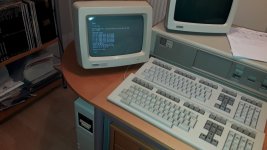
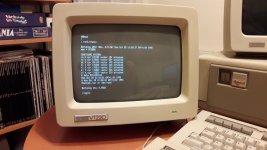
SMS 1000 BOOTSTRAP
512 KW MEMORY 11/23 CPU
BOOTABLE DEVICES:
DEVICE DEVICE UNIT
NAME TYPE NUMBERS
DU DSA 0-3
MS TS 0
ENTER DEVICE NAME AND UNIT NUMBER: DU
40Boot
:
: ra(0,0)unix
Berkeley UNIX (Rev. 2.9.1) Fri Nov 5 19:46:04 GMT+1:00 1993
mem = 950912
CONFIGURE SYSTEM:
ra 0 csr 172150 vector 154 attached
ts 0 csr 172520 vector 224 attached
dz 0 csr 160100 vector 400 attached
kl 1 csr 176500 vector 300 attached
kl 2 csr 176510 vector 310 attached
kl 3 csr 176520 vector 320 attached
kl 4 csr 176530 vector 330 attached
kl 5 csr 176540 vector 340 attached
# date 9311061011
Sat Nov 6 10:11:00 GMT+1:00 1993
# Sat Nov 6 10:11:07 GMT+1:00 1993
Mounted /usr on /dev/ra0c
Berkeley Unix 2.9BSD
;login:
The 2.9BSD system is not Y2K compatible, therefor I operate the system in the year 1993. With this, at least the days of the week are right ;-)
Why 2.9BSD? Because this is the most modern Unix system which still runs on a PDP-11/23. Further my SMS1000 was built in 1986 and the operating system is also from this time.
If anyone would like to run a 2.9BSD system on a PDP-11 with an MSCP controller that does not come from DEC - please ... if there is a download area here, I will be happy to make the material available for you here. It includes also a kernel for the PDP-11/73.
Greetings from Austria,
Peter
Maybe one of you also has a PDP-11 which was not made by DEC, like my SMS 1000 and maybe someone would like to run Unix on this PDP-11. In any case, I have put together a 2.9BSD system for my SMS-1000 Model 40, which works with the SMS MSCP Controller as well as it supports the SMS QIC02 tape controller.
Why? - Because I recently acquired such a system and it is claimed on the Internet that the MSCP controller of SMS only works with RT-11 - I wanted to find out if this is true.
Conclusion: Myth busted!


SMS 1000 BOOTSTRAP
512 KW MEMORY 11/23 CPU
BOOTABLE DEVICES:
DEVICE DEVICE UNIT
NAME TYPE NUMBERS
DU DSA 0-3
MS TS 0
ENTER DEVICE NAME AND UNIT NUMBER: DU
40Boot
:
: ra(0,0)unix
Berkeley UNIX (Rev. 2.9.1) Fri Nov 5 19:46:04 GMT+1:00 1993
mem = 950912
CONFIGURE SYSTEM:
ra 0 csr 172150 vector 154 attached
ts 0 csr 172520 vector 224 attached
dz 0 csr 160100 vector 400 attached
kl 1 csr 176500 vector 300 attached
kl 2 csr 176510 vector 310 attached
kl 3 csr 176520 vector 320 attached
kl 4 csr 176530 vector 330 attached
kl 5 csr 176540 vector 340 attached
# date 9311061011
Sat Nov 6 10:11:00 GMT+1:00 1993
# Sat Nov 6 10:11:07 GMT+1:00 1993
Mounted /usr on /dev/ra0c
Berkeley Unix 2.9BSD
;login:
The 2.9BSD system is not Y2K compatible, therefor I operate the system in the year 1993. With this, at least the days of the week are right ;-)
Why 2.9BSD? Because this is the most modern Unix system which still runs on a PDP-11/23. Further my SMS1000 was built in 1986 and the operating system is also from this time.
If anyone would like to run a 2.9BSD system on a PDP-11 with an MSCP controller that does not come from DEC - please ... if there is a download area here, I will be happy to make the material available for you here. It includes also a kernel for the PDP-11/73.
Greetings from Austria,
Peter

